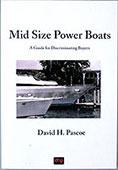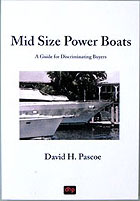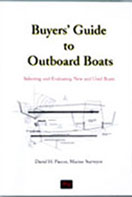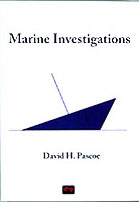PURSUIT 3000 OFFSHORE
by David Pascoe
| LOA | 31'2" | Year | 1998 |
| Beam | 12'0" | Engines | Volvo 260 |
| Draft | 2'9" | Options | Crusader 454, Cummins 315 |
| Weight | 11,500 | Fuel Cap. | 250 gals. |
| Years built | 1995-02 | Top Speed | 25.1 kts. |
Definitely a dedicated fisherman, the Pursuit 3000 has much to offer the serious angler, starting with a twelve foot beam on a 31 footer and an extra large cockpit. Pursuit makes some boats that they call "express fisherman" but this one won't leave you with any illusions about it doubling as a booze cruiser. Unless, of course, your guest like sitting on the gunwale. It's distinguished by the notable lack of seating and the tall wrap-around cockpit coaming topped by a 6" wind deflector but no windshield to speak of. And with three pedestal chairs forward, there is seating only for three unless one uses the center island as a seat, which everyone aboard does.
This style was originally born of a custom boat builder (Rybovich, if I'm not mistaken) and is one of the more nicely styled examples. Numerous builders have put out a boats of its type including Luhrs, Topaz, Bertram, Hatteras and a few other lesser knowns such as the Rybo Runner. Its distinguishing feature is the raised coaming with no windshield frame.
To keep the water off, one relies on removable soft enclosures that, on this boat, are very easy to put up and take down, a nice feature on those days of 90+ degrees and humidity with no wind. With the enclosures down and the boat moving, air flows nice under the tower for some natural air conditioning. And besides, who likes to look though those vision-distorting plastic windows?
As thirty footers go, this seems like a big boat. That's mainly due to a lack of clutter that yields a large cockpit, interrupted only by the center island. I've been on a number of boats with islands like this, the most distinguishing characteristic of which I noted was the tendency to walk into the damn things, so when I approached the Offshore 3000 I thought "Uh, oh!"
I found myself pleasantly surprised at the end of the day when the island proved to be no problem at all. Containing a live bait well, small tackle box and bait cutting board atop, I found myself using it as a convenient seat at times and a table at others. Those of you who are frequent readers know that I'm obsessive about cluttered deck areas and good ergonomics and traffic patterns. Well, this layout really works OK despite my first impression that it might not be so good.
The one aspect that I didn't like was the way the fish box was built into the transom gunwale juts out into the cockpit, breaking up the smooth line of most belly rails. Fortunately it doesn't interfere with the opening of deck hatches because someone was thoughtful enough to design the hatch so that it is not interfered with by the overhanging box. Here we've got a wide (about 48") but narrow hatch across the deck that yields access to rudders, bilge pump, steering gear, etcetera.
This one is fitted with the optional shorty tower, aka marlin tower, that is nicely designed and doubling as a bridge with seating for two. Apparently it's this lack of a superstructure that gives the boat a very stable feel to her. We came to a dead stop out in the Gulf and the rolling moment was negligible. Nice.
If you expect to see one of those great Tiara helm panels you'll be disappointed. With a center helm, this one is decidedly plain-Jane and unremarkable. The companionway down into the cabin is a tad narrow and the three pedestal chair arrangement, while a little cramped, is not too bad.
For engine compartment access we have a center hatch which drops you down between the two engines and where the bilge here is fairly deep. Here we have standing room only, as when I tried to bend over to get in there to check the oil, etcetera, there wasn't room to move. So, we go through the long wait for the electric openers to lift the large hatch section up two feet at one end to an engine compartment that's like crawling into an alligator's mouth.
Well, it's really not all that bad, but one does end up stepping on a lot of things that shouldn't be stepped on before one has his feet firmly planted on deck. At this point you can stand up -- albeit hunched over -- and move rather freely to do your thing, like trying to get three foot long dipsticks back into the hole with the dang things bending like spaghetti.
Actually, these Volvo KAMDS44 engines fit pretty well with the exception of it being really tough to get at the outboard side of the port engine, and hard to do things like adjust belts and service water pumps at front of engines. Otherwise, there's good access to batteries, strainers, filters and so on for the do-it-yourselfer. Shafts have lip seals, there are full size bronze strainers and Racor filters standard.
Sitting at the aft end is a Next Gen 5.0Kw gen set that after five years seems to be doing well. The Volvo engines likewise are doing well but for bad gaskets on both turbos and a leaking fuel pump.
As one can imagine, with only 520 hp performance is not spectacular, topping out at 25.1 knots with a cruise at 3200 RPM of around 20 knots or you can bump it up to 3400 for 21+ knots. Her strong suit will be range and fuel economy running at about 16 gph at low cruise. Earlier models had Vovlo 230's making for a very slow boat and wisely they abandoned that engine in a hurry. If you want to go faster, Crusader 454's and Cummins 315's will push her speeds of 31+ knots but that single 250 gallon fuel tank will empty in a hurry.
The hull is noticeably deeper than typical Pursuit hulls of earlier years and this was reflected in a much improved ride. The motion in an undulating two foot swell was easy and almost pleasant; it has the feel of a heavy boat. And with heavy bow flare, she's quite dry.
The hull sides are balsa cored but the bottom is solid glass. Cockpit deck is NidaCore plastic honey comb. Stringers are glass over plywood, but are heavily and completely glassed with excellent attention to detail.
The cabin is generally unremarkable with vee berth forward and a convertible upper/lower berth to starboard. The upper, because of the angle of the deck jutting out, I would describe as unusable. The galley is against the aft bulkhead (see photo) with a tiny sink, under-counter reefer, and microwave faced in an overhead cabinet above. Head compartment is smallish but useable with a glass liner. Sit on the pot and take a shower if you dare!
I'd size her up as having good, solid design while giving very good quality for the price. Good performance, clean intelligent design, simple systems and easy maintenance are her strong points.
Posted April 19, 2002
 Visit davidpascoe.com for his power boat books
Visit davidpascoe.com for his power boat books 














David Pascoe is a second generation marine surveyor in his family who began his surveying career at age 16 as an apprentice in 1965 as the era of wooden boats was drawing to a close.
Certified by the National Association of Marine Surveyors in 1972, he has conducted over 5,000 pre purchase surveys in addition to having conducted hundreds of boating accident investigations, including fires, sinkings, hull failures and machinery failure analysis.
Over forty years of knowledge and experience are brought to bear in following books. David Pascoe is the author of:
In addition to readers in the United States, boaters and boat industry professionals worldwide from nearly 80 countries have purchased David Pascoe's books, since introduction of his first book in 2001.
In 2012, David Pascoe has retired from marine surveying business at age 65.
On November 23rd, 2018, David Pascoe has passed away at age 71.
Biography - Long version